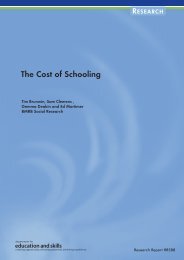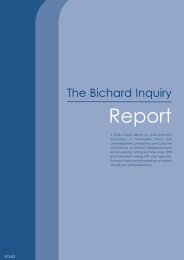<strong>Recognis<strong>in</strong>g</strong> <strong>and</strong> Record<strong>in</strong>g Progress <strong>and</strong> Achievement <strong>in</strong> Non-accredited Learn<strong>in</strong>gThe quality of such programmes can be assuredby sampl<strong>in</strong>g tutor records, teach<strong>in</strong>g <strong>and</strong> learn<strong>in</strong>gobservation records or other suitable approachesthat will provide the assurance the learn<strong>in</strong>g providerfeels is appropriate to these programmes.Learner is at the centre <strong>and</strong> enhance the learners’experience39 The evaluation of the pilot projects clearlydemonstrated that RARPA benefits learners <strong>and</strong>enhances learn<strong>in</strong>g. By focus<strong>in</strong>g on the learner,the staged process engages tutors <strong>in</strong> an ongo<strong>in</strong>gdialogue about the learner’s learn<strong>in</strong>g <strong>and</strong> ensures thatthe personal aims <strong>and</strong> motivation of the learnercan be accommodated by the learn<strong>in</strong>g programme.Non-accredited learn<strong>in</strong>g does not normally havethe formal syllabus content or assessment criteriaof accredited learn<strong>in</strong>g. This has to be providedby the tutor <strong>and</strong> supported by the learn<strong>in</strong>g provider.The personal reasons the learner has for participat<strong>in</strong>g<strong>in</strong> the learn<strong>in</strong>g activity become central to their <strong>progress</strong><strong>and</strong> successful outcomes to learn<strong>in</strong>g. The staged processcaters for this <strong>and</strong> also for identify<strong>in</strong>g learn<strong>in</strong>goutcomes that were not expected at the startof the programme <strong>and</strong> which, when recorded,also <strong>in</strong>dicate that the learner has had a successfullearn<strong>in</strong>g experience.Complement <strong>and</strong> <strong>in</strong>tegrate with exist<strong>in</strong>g processes40 RARPA should not create additional systemsor <strong>record<strong>in</strong>g</strong>. Providers are already expected to collectsufficient <strong>in</strong>formation about the learn<strong>in</strong>g they offer,accredited <strong>and</strong> <strong>non</strong>-accredited, to <strong>in</strong>form their selfassessment<strong>and</strong> quality improvement activities.Inspection f<strong>in</strong>d<strong>in</strong>gs <strong>in</strong>dicate that whilst many providersare <strong>in</strong> this position, there are still unsatisfactorycontributory grades for quality assurance,<strong>and</strong> weaknesses <strong>in</strong> quality improvement. Where thisis the case, providers need to improve their qualityassurance processes to the position the LSC<strong>and</strong> <strong>in</strong>spectorates expect them to have reached,ensur<strong>in</strong>g that all learn<strong>in</strong>g is valued <strong>and</strong> evaluated.Further <strong>in</strong>formation can be found <strong>in</strong> QualityImprovement <strong>and</strong> Self-assessment (LSC, 2005)(www.lsc.gov.uk/National/Documents/Read<strong>in</strong>gRoom/default.htm).New Common Inspection Framework41 Under the new Common Inspection Framework(CIF), <strong>in</strong>spection will place more emphasis on check<strong>in</strong>gthe capacity of providers to accurately assurethe quality of their provision <strong>and</strong> improve or ma<strong>in</strong>ta<strong>in</strong>st<strong>and</strong>ards. The self-assessment report <strong>and</strong> qualityimprovement plan will be key evidence for this.42 Under the new <strong>in</strong>spection arrangements, two newoverall judgements will be made:• ‘the overall effectiveness of the provision,<strong>in</strong>clud<strong>in</strong>g any extended services, <strong>and</strong> its ma<strong>in</strong>strengths <strong>and</strong> weaknesses• the capacity to make further improvements.’43 Providers need to ensure that their selfassessmentreports <strong>and</strong> mechanisms for <strong>record<strong>in</strong>g</strong>learners’ <strong>progress</strong> <strong>and</strong> success are comprehensive,consistent <strong>and</strong> effective. The application of RARPAwill help to achieve this.44 Further <strong>in</strong>formation about RARPA <strong>and</strong> the newCommon Inspection Framework can be found<strong>in</strong> paragraphs 49 to 53.The Application ofRARPA45 The RARPA approach will be <strong>in</strong>troduced acrossLSC-funded <strong>non</strong>-accredited provision from September2005. From this date, providers receiv<strong>in</strong>g LSC fundsfor <strong>non</strong>-accredited provision will be expected to have<strong>in</strong> place a plan for implement<strong>in</strong>g RARPA across suchprovision dur<strong>in</strong>g 2005-06. This will be summarisedthrough a statement about the implementationof RARPA <strong>in</strong> providers’ three-year development plans.46 2005-06 is an embedd<strong>in</strong>g year for RARPA.Providers are not expected to have fully implementedthe approach <strong>in</strong> September 2005 but to develop theirprocesses so that the self-assessment report for2005-06 covers all learn<strong>in</strong>g, accredited<strong>and</strong> <strong>non</strong>-accredited, <strong>and</strong> that RARPA then formspart of the normal quality cycle for the provider.47 From September 2006, all providers receiv<strong>in</strong>g LSCfund<strong>in</strong>g will be expected to apply the RARPA approach<strong>in</strong> full to <strong>non</strong>-accredited provision.48 The actions that providers need to take are to:• ensure the quality assurance processes,self-assessment <strong>and</strong> quality improvementplann<strong>in</strong>g <strong>in</strong>clude all provision, accredited<strong>and</strong> <strong>non</strong>-accredited• review teach<strong>in</strong>g <strong>and</strong> learn<strong>in</strong>g strategiesfor <strong>non</strong>-accredited learn<strong>in</strong>g to ensure thatthe staged process can be applied to teach<strong>in</strong>gpractices <strong>in</strong> a way that ensures the stagedprocess is be<strong>in</strong>g applied to the benefitof learners6
<strong>Recognis<strong>in</strong>g</strong> <strong>and</strong> Record<strong>in</strong>g Progress <strong>and</strong> Achievement <strong>in</strong> Non-accredited Learn<strong>in</strong>g• review their quality assurance systemsto ensure that sufficient <strong>in</strong>formationis collected <strong>in</strong> a suitable way to allowself-assessment decisions to be taken• review their data collection systemsto ensure that these are fit for purpose<strong>and</strong> not unnecessarily bureaucratic• develop, as necessary, self-assessment report<strong>in</strong>gprocesses for 2005-06 to cover all provision,accredited <strong>and</strong> <strong>non</strong>-accredited• implement RARPA for E2E provision fromSeptember 2005.RARPA <strong>and</strong> the NewCommon InspectionFramework49 The staged process was mapped to the oldCommon Inspection Framework <strong>and</strong> has beenre-mapped to the new CIF. Table 2 <strong>in</strong>dicates howthe key questions relate to the staged process.50 Diagram 1 below summarises the key questionsthat providers need to consider <strong>in</strong> their self-assessment<strong>and</strong> that will be asked of them at <strong>in</strong>spection.Diagram 1: The Common Inspection Framework for Education <strong>and</strong> Tra<strong>in</strong><strong>in</strong>g from 2005The key questions <strong>in</strong>spectors must ask every provider of education <strong>and</strong> tra<strong>in</strong><strong>in</strong>g are:Overall effectiveness:• How effective <strong>and</strong> efficient are the provision <strong>and</strong> related services <strong>in</strong> meet<strong>in</strong>g the full rangeof learners’ needs <strong>and</strong> why?the overall effectiveness of the provision, <strong>in</strong>clud<strong>in</strong>g any extended services, <strong>and</strong> its ma<strong>in</strong> strengths<strong>and</strong> weaknesses• What steps need to be taken to improve the provision further?the capacity to make further improvementsAchievement <strong>and</strong> st<strong>and</strong>ards:1 How well do learners achieve?The quality of provision:2 How effective are teach<strong>in</strong>g, tra<strong>in</strong><strong>in</strong>g <strong>and</strong> learn<strong>in</strong>g?3 How well do programmes <strong>and</strong> activities meet the needs <strong>and</strong> <strong>in</strong>terests of learners?4 How well are learners guided <strong>and</strong> supported?Leadership <strong>and</strong> management:5 How effective are leadership <strong>and</strong> management <strong>in</strong> rais<strong>in</strong>g <strong>achievement</strong> <strong>and</strong> support<strong>in</strong>g all learners?51 The application of RARPA will make a positivecontribution to the overall effectiveness of provisionby demonstrat<strong>in</strong>g that a provider recognises,records <strong>and</strong> evaluates all learn<strong>in</strong>g <strong>and</strong> is capableof identify<strong>in</strong>g <strong>and</strong> plann<strong>in</strong>g improvements.52 Table 2 maps each stage of the staged processto CIF questions 1-4.7
















